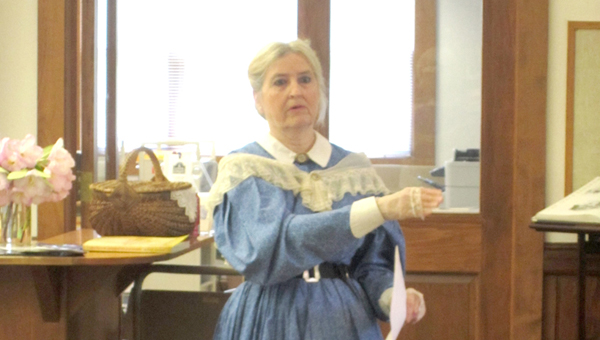Shields: Connecting 150 years later
Published 7:52 pm Thursday, April 26, 2012

Aliene Shields, wearing period costume, tells the audience at the April 19 Lanier Library Brown Bag Lunch about the Civil War experiences of her great-great-grandfather, Private Thomas Marion Shields of the 3rd S. C. Infantry, based on letters her family has preserved. (photo by Barbara Tilly)
Shields tells Civil War story through family letters
The banjo sounds of “Soldier’s Joy” met latecomers as they arrived at Lanier Library’s Brown Bag Lunch on Tuesday, April 19. The traditional tune was appropriate both because the event featured Aliene Shields speaking about some of her family’s Civil War experiences and because the performer was her relative, Shields Flynn.
Aliene, dressed in period costume, told the story of her great-great-grandfather, Private Thomas Marion Shields of the 3rd S. C. Infantry, based on letters that her family has preserved. Also based on those letters, she has published a book, “The Legacy of a Common Civil War Soldier: Private Thomas Marion Shields,” which she wrote with historian Mac Wyckoff.
Thomas Marion Shields and his wife, Amanda (Steadman), lived in Fingerville, S.C., just south of the North Carolina line where Rutherford County abuts what was then Spartanburg District, near the intersection of today’s Hwy. 9 and Hwy. 11. The original New Hope Baptist Church, later moved to Polk County, was built on Shields property in 1859. The family was related to the Camp, Patterson, Gilbert, Harris and Waters families on both sides of the border.
Aliene said she initially had 28 letters Thomas wrote and later found six more in the possession of other family members in Gettysburg, Pa. A retired teacher, she said she decided to write a book because she felt it was important to tell the story of the common soldiers and their families in the Civil War. She was also challenged to write the book by Walter Slocum, an acquaintance who is descended from Major General Henry Warner Slocum.
“I want to help keep the memory alive of Thomas and Amanda,” Aliene said.
The existence of the letters is amazing for many reasons, Aliene said. First, unlike many of the common soldiers at the time, Thomas could read and write. Amanda, however, could not, so she had to have help from a neighbor to read his letters and write hers in return.
It was also hard to find paper to write on, Aliene said. Letters were written on anything that could be made to work. For example, she said, once a letter had been received, it might be turned upside down and the reply written between the lines of the original letter, on the edges and anywhere else where there was space.





